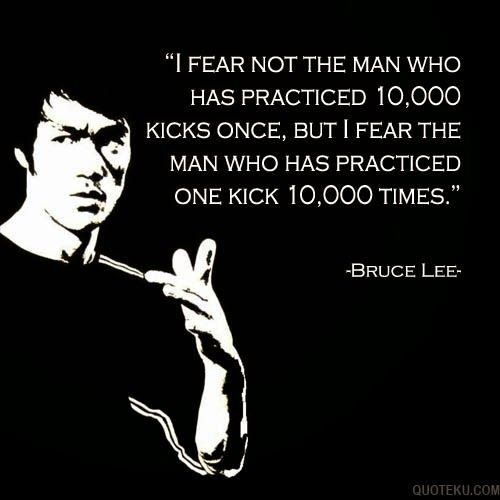In the post In Praise of Effort, Priya talks about the effectiveness of being consistent with your efforts as a habit. She shows how an overnight success is often glorified and untrue, when in truth those success stories ran several days, months or years in the making. In fact, more than your talent, it is your ability to show up and put in the work everyday that defines your success or failure. Martial arts expert and actor Bruce Lee summed it up as, “I fear not the man who has practised 10,000 kicks once, but the one who has practised one kick 10,000 times.”
In praise of routine
A famous quote says that ‘Rome wasn’t built in a day’. We can extend the saying to the Eiffel tower, Pyramids and Taj Mahal. Neither Unilever nor P&G became FMCG giants overnight. It took them years to perfect both their products and their distribution channels. Microsoft’s first release of commercial Windows started with Windows 1.0 in 1985. It was so different and rudimentary from what we see today. Mobile phones looked like cordless handsets and you could only send and receive phone calls. The screen supported only 3 lines of text in black colour on a green back-lit screen.

If you see a success story, and the story claims that the success happened overnight, raise your eyebrows in suspicion. Dive deep down into the real story of how the creator fell in love with routine. In all success stories, the creator(s) showed up everyday and put in the hour required. In every story, the real road to success was long, hard, filled with routine and there were few shortcuts, despite what any narrator wants you to believe. To humans, shortcuts and magic wands sound more interesting that several hours of routine and mundane hard work.
Benefits of routine
We agree that all success stories are a product of days, months or even years of routine. What are the benefits of following a routine? Let’s see some points.
Establishes your commitment: When you show up for something daily and are willing to put in the hours, it shows how much committed you are to that goal. Sometimes you show up willingly with the enthusiasm of a newbie or with a renewed passion. But nearly half the time, you have to drag yourself. If you show up often enough, work often enough and learn often enough, eventually you will achieve your goal. Your commitment will see you through.
Teaches you everyday: When you make plans on paper, you foresee some predictable troubles along the way. However, forming a routine and actually doing something everyday exposes some new troubles that you couldn’t have predicted. Planning and executing are very different. You need to be on the field to learn and document obstacles that can’t be thought beforehand. A routine forces you to face those ugly challenges and truly become an expert.
Compounds your growth: In the world of finance, you will often learn about compound interest. It says that an investment grows higher the longer you stay in it. Along with the original amount you invested, whatever interest you earned on that amount along the way also gets to grow. Your past earnings will be included in every new growth.
Let’s say you invest ₹ 1,000 in a financial instrument X, that earns you 10% interest every year. In the first year, you will earn ₹ 100 and turn your worth into ₹ 1,100. Please note that next year, your interest will now be calculated on ₹ 1,100 and not just on the original ₹ 1,000 that you invested. The interest earned will also be included in your new growth.
Routine makes your progress to your goal grow in the same way. You may think that your session at the gym today will tone your muscles in a certain way. But if you are regular, then the effects of yesterday’s session are not over yet and they will combine with today’s session. If you read everyday, not only do you gain new knowledge, but your brain automatically tries to find links between what you learnt previously and give you a bigger picture. You many find links between two unrelated fields.
This compounding may be why you are unable to lift a 10 kg dumbbell on your first day at the gym, but are able to do so on day 30. This is also the reason why you can hardly make out the differences between the letters in Arabic script on day 1, but by day 60, you can read 3 lines in a minute and eventually, in a year, you can read entire news articles.
Makes your goal accessible: Planning to run a 42-km marathon looks daunting on the day you decide on the goal. Unless you establish a routine to run and grow in technique and stamina everyday, that goal will stay daunting.
Showing up everyday, with the effect of compounding is what makes your goals look possible and accessible day by day. Goals like these are so overwhelming that the only way to get close to them is with routine and daily practice.
Setting your routine
Routine isn’t as dry as the world makes it out to be. A good routine is in the form of deliberate practice, a term used often by psychologist Anders Ericsson, who wrote a paper about how 10,000 hours of deliberate practice can potentially make you an expert. You apply your mind, body and soul to it every day. It can be the difference between how we cut onions in a drab way every day and how an expert chef cuts it artistically. Instead of just showing up and putting in the work, you should also do the following to get more out of your routine.
Set your goal for the day: This step is done before diving into your routine. Here, you decide where you want to be today in comparison to where you finished yesterday. If you completed 15 repetitions with 10 kg dumbbell today, you should aim for 18 reps or 11 kg. Note that a tiny improvement will do: it can be just 1%. Remember, compounding will make it 20% sooner than you think. To give your goal a push in the right direction, your first step should be to set a goal for the day.
Measure your performance: At the other end of the spectrum is to measure what was done today. Did you touch your goal line, did you blast through it, did you fall just short or well short? Only measurement will tell you. You should log your practice in some way. In workouts, there are several apps like Endomondo that can tell you about your performance in endurance sports like running, bicycling and swimming. For dumbbell based exercises, you should use logs like a notebook or an Excel sheet. There are measurements that you can’t make with numbers, but rather with diagrams or checklists. E.g. what modules of software you completed today can be measured by drawing a master flowchart during the goal setting phase and then by shading out the parts of the flowchart that you completed. Articles you plan to blog about this month can go into a checklist and ticks can be made against the ones you completed.
Review your learnings: Did you stay on course for your goals? Did you face new challenges that you overcame? Did the challenges derail you? What can you do to overcome them tommorrow? Did you underestimate your problems? Did you get too ambitious with the planning that couldn’t be achieved realistically? All these questions can be answered as you review your measurements and draw inferences. Even a ten-minute review will teach you a lot of lessons for the future and participate in compounding your growth during tommorrow’s session.
Don’t miss two days in a row: Some days, you may not be able to go through with your routine. You may be on a holiday with your family. You may have a festival at your home. You may be sick. You should try not to miss two days in a row. Does your current situation need some tiny adjustments to accommodate your routine? Plan the adjustments and get back on track. Sometimes it is possible to know about your situation in advance and plan adjustments. E.g. you know that Internet will be patchy during your next holiday, so you can gather offline material. Try not to skip your routine again.
But take a break when you need to: However there are situations when your best efforts cannot accommodate your routine. A prolonged sickness is a reason. For us, our blogging habit came crashing down when we used a motorbike to drive around north-east India as part of trip India 360. Internet connection was dismal, the roads bumpy and the weather unpredictable. All said, we decided to leave our laptop behind at my sister’s place in Assam. The situation didn’t do us any favours to carry our laptop or post content online. We decided to shelve our routine until the end of our trip.
Conclusion
Consistency is the formula to success and it trumps raw talent and skill. Embrace routine and consistency. You should be happier as a consistent performer rather than as a top performer. Top performers are celebrated during their exploits, but forgotten or questioned when they are off their peak. Consistent performers are respected for eternity.


One year of nomad living, made me appreciate the routine more. Keeping track of progress everyday is very frustrating, the goal attitude is like counting chickens before they hatch. However the process attitude , i.e the routine keeps us working at our process even when results are not immediate or visible. But progress happens and then the transformation. Then you become a overnight success 😀
True, what appears overnight is actually just a tipping point.